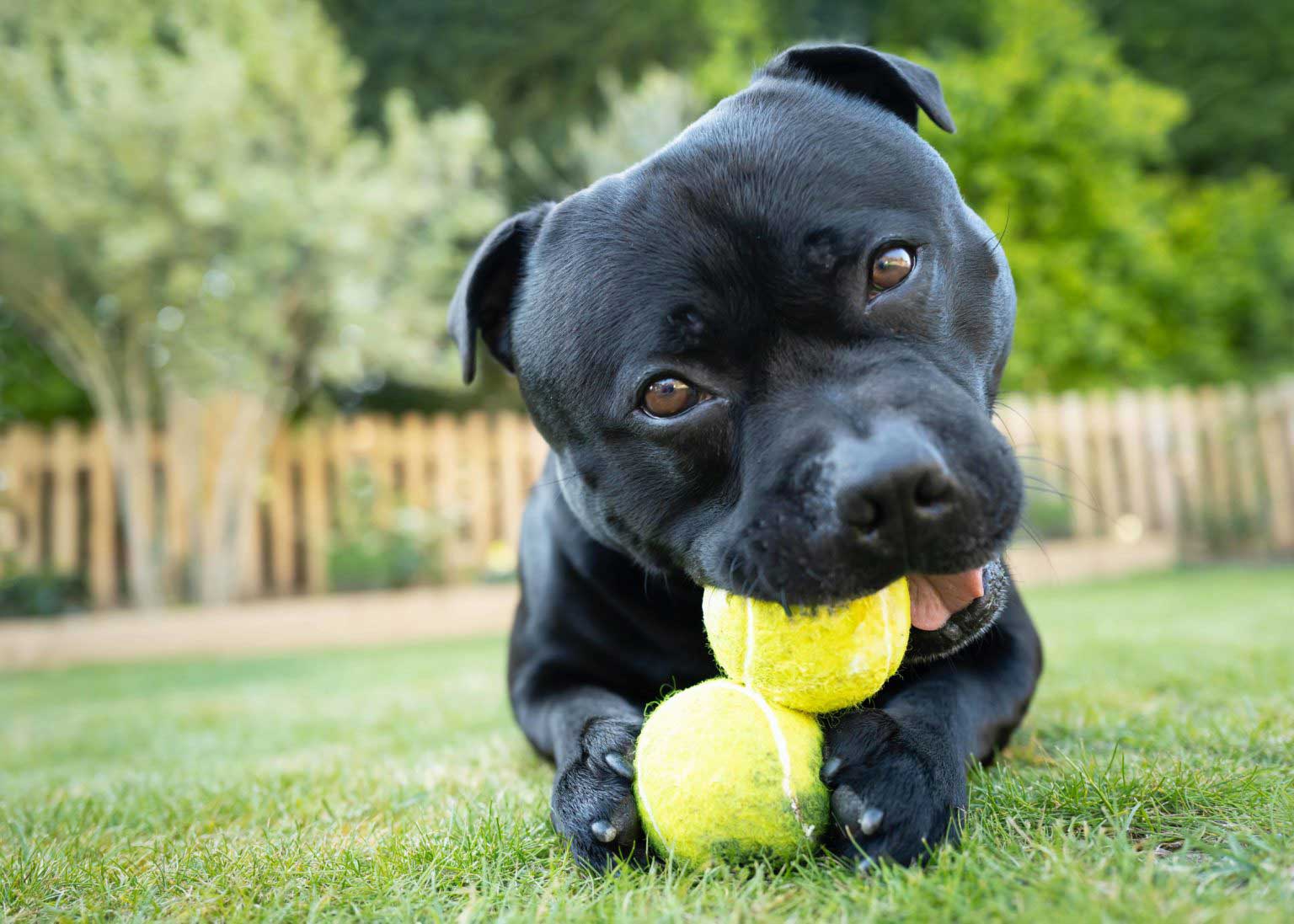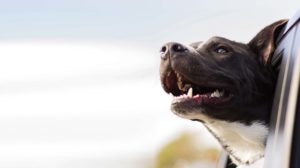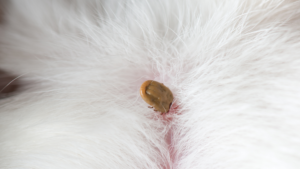Staffordshire Bull Terrier| Traits | training | Typical health problems
This section outlines the Staffy traits, training and typical health problems.
Staffordshire Bull Terrier| Breed highlights
| Breed: | Staffordshire Bull Terriers (Staffies) are medium-sized dogs. The breed is most recognisable for its muscular body, broad, squarish headand wide jaw. |
| Coat type: | Staffies are short-haired, and their coat sits flat to the skin. |
| Shedding: | Staffies shed moderately throughout the year; however, they experience one heavy shedding period before summer. |
| Grooming: | Staffies require light brushing once a week to remove excess fur and keep the coat shiny. |
| Activity level: | Staffies are an active breed and will require at least two 30-minute walks/runs a day. |
| Apartment friendly: | Staffies can live in apartments if exercised. However, they are better suited to homes with outdoor space. |
| Small children: | Suitable for families with children. Pups are excitable, so supervision with small children is always recommended. |
| Other dog friendly: | Staffies can be unpredictable with other dogs. Keep this breed on a leash in open spaces with unfamiliar dogs. |
What type of breed is a Staffordshire Bull Terrier?
Staffies are a solid and compact mid-sized breed. Although their stocky appearance can appear intimidating, it belies a playful nature and an unparalleled dedication to their owners. The breed, classified as part of the terrier group, is always popular and ranks highly on the top ten lists of most desirable dogs
History of Staffordshire Bull Terrier
Staffies originated in Staffordshire, England, in the 1800s. The breed is a mix of Bulldogs and the now-extinct White Terrier. Bred first as fighting dogs, Staffies, despite their relatively small stature, were pitted against bears and bulls. The breed’s key traits were – and remain – strength and fearlessness, and a powerful set of jaws. Although no longer fighting dogs, Staffies retain the legacies of their breeding: they are enthusiastic, highly energetic, playful, and strong-willed; they will chase small animals and can get into fights with other dogs.
Staffordshire Bull Terrier appearance and characteristics
Staffies are a short-haired breed with fur that sits against the skin. The breed comes in various colours, including red, fawn, black, white, blue or brindle. Staffies can also be a mix of these colours.
Staffies stand between 36 and 41 centimetres tall and can weigh between 11 and 17 kilograms. Females are generally a bit smaller. Staffies are an active breed and need daily exercise. Managing their energy can mean exercising more than once a day. Different types of activity can include walking, running, or fetching a ball. Without plenty of exercise, the breed is prone to weight gain. Extra body weight can result in health problems affecting the joints.
Staffordshire Bull Terrier personality and temperament
As a breed, the Staffies are considered friendly, playful and loyal to its family. Staffies are known to be especially good with children; they have a gentle, almost protective nature. As with any dog around children, supervision is always recommended.
While generally good-natured, Staffies instinctively chase or fight and can be stubborn. Obedience training, like puppy preschool from a young age, helps with socialising with other dogs and allows owners to become more confident with handling.
Staffordshire Bull Terrier traits
Staffies love to be with people, and while they can be left alone for a few hours, this shouldn’t be all day. Bored or distressed Staffies can display destructive chewing or digging behaviours.
Exercise for the breed is a must. However, given Staffies are also smart, they do well with any activity that gives them a chance to use their minds. Generally, they are satisfied playing fetch with their owner. It’s worth noting as well that Staffies are prone to overheating, so in summer, plan walk times carefully or include a swim.
Staffordshire Bull Terrier Lifespan
Staffordshire Bull Terriers live between 12 and 14 years.
The dos and don’ts of caring for a Staffordshire Bull Terrier
Do: Bathe your Staffie when needed and use a gentle soap formulated for sensitive skin. If you notice a musty or yeasty smell emanating from your Staffie, don’t disregard this. It could be a symptom of a bacterial infection and will need a vet check.
Don’t: Forget the importance of a good diet! Staffies have voracious appetites and will eat practically anything placed in front of them. However, some foods can trigger skin problems, and the wrong type of food can lead to weight issues. Therefore, it is always best to discuss dietary requirements with your vet. They can recommend the best food for your Staffie’s health and well-being.
Do: Brush your Staffie’s fur at least once a week to remove any build-up of dead hair and to keep their coat shinydand also keep an eye on their nails. Nails need trimming if they have become overgrown, or you can hear them tapping as they walk. To learn a vet-approved technique, watch PetSure’s Nail Clipping Masterclass series.
Common conditions for Staffordshire Bull Terrier
| Conditions | Symptoms can include~ | Highest cost for a single treatment* |
| Skin Conditions including – infections and allergic skin disorder | · Scratching, biting or rubbing the skin · Signs of irritation including red skin, scabs, bleeding, pustules or weeping · Hair loss, flaky skin, texture changes, lumps or an unusual or unpleasant smell | $6,872 |
| Gastrointestinal (tummy) problems | · Diarrhoea, vomiting or constipation. · Blood or mucous in stool/vomit. · Increased frequency/urgency passing stool. · Weight loss. · Loss of appetite and interest in food. · May seem more tired than usual. | $13,939 |
| Neoplasic or Mass Lesions | · Mast Cell Tumours, Lymphomas, Sarcomas, Adenocarcinoma and Osteosarcoma · Lumps and bumps underneath the skin. · Abdominal swelling. · Sudden weight loss. · Change in appetite. · Lethargy or depression. · Changes in bathroom habits. | $11,334 |
| Traumatic accidents, including bite, injuries, wounds and broken bones | · Signs of pain or discomfort after an accident or injury. · Limping or whining. · Wounds or scratches, broken nails and other signs of trauma | $6,922 |
| Ear Conditions -including infections and allergies | Ear Conditions -including infections and allergies | $8,239 |
Disclaimer: Reimbursement for these claims would be subject to limits, such as annual benefit limits or sub-limits, benefit percentage, applicable waiting periods and any applicable excess. Cover is subject to the policy terms and conditions. You should consider the relevant Product Disclosure Statement or policy wording available from the relevant provider.
* Please note that the values calculated are based on all claims for that condition and medically related conditions in each calendar year.
Types of pet insurance from PetSure
| Policy type | Policy description |
| Accidents | This product provides cover for specified accidental injuries up to an annual policy limit. Most policies will reimburse a stated Benefit Percentage that is typically 80% of eligible vet bills. Some condition sub-limits may also apply, with all annual limits resetting each year when the policy is renewed. It’s important to know that only defined accidents as listed in the policy’s Product Disclosure Statement will be covered (other conditions will not be covered). More information on what is typically covered and not covered in our find a policy page. |
| Basic care | This product provides limited cover for both specified accidental injuries and illness conditions, with a stated Benefit Percentage that can range from 60-90%. Treatments and medications for eligible conditions are typically covered subject to the applicable policy limits. Claimable conditions have an annual condition limit , meaning once the condition limit (subject to the annual benefit limit) has been reached in an annual policy period, costs relating to that condition will need to be covered entirely by the policyholder. However, annual benefit limits and applicable annual condition limits reset on renewal each year. More information on what is typically covered and not covered in our find a policy page. |
| Comprehensive / Accident and Illness | This product provides comprehensive cover for both specified accidental injuries and illness conditions, with a stated Benefit Percentage that will typically range from 70-85%. You can claim up to an annual maximum limit each year, which resets on renewal. Sub-limits for certain items may also apply. More information on what is typically covered and not covered in our find a policy page. |
Insurance products are issued by The Hollard Insurance Company Pty Ltd ABN 78 090 584 473, AFSL 241436 (Hollard) and/or PetSure (Australia) Pty Ltd ABN 95 075 949 923, AFSL 420183 (PetSure) (from 8 May 2023 only), administered by PetSure and promoted and distributed through their authorised representatives and distribution partners.
Any advice provided is general only and does not take into account your individual objectives, financial situation or needs. Cover is subject to the policy terms and conditions. Please consider the Product Disclosure Statement (PDS) to ensure this product meets your needs before purchasing, or choosing to continue with the product. PDS and Target Market Determination available on our partners’ websites. Meet our partners at petsure.com.au/partners.
To read more detailed information about the different types of Pet Insurance policies available, our find a policy page goes through the different types of pet insurance policies available to help you find the right fit for your pet.
Pet insurance can help by covering a portion of the eligible vet bill if the unexpected happens. Because it is difficult to predict the costs of veterinary care, it can help to have measures in place to help prepare for the unexpected. Check out our partner network and explore our policy tools to find a pet insurance policy.
Not all conditions or items are covered by Pet Insurance. Refer to the applicable Product Disclosure Statement for information about coverage and exclusions.
Frequently Asked Questions
Staffies have a reputation for being smart and responsive to training. However, the breed has a stubborn streak, so patience and persistence are needed when introducing new commands.
Yes! Staffies have powerful jaws, and they like to chew. Chewable toys are highly recommended.
The top names for staffies born in 2022 were:
1. Luna
2. Daisy
3. Charlie
4. Coco
5. Frankie
6. Teddy
7. Milo
8. Archie
9. Bella
10. Ruby
Fun fact
The late Steve Irwin described his brindle Staffordshire Bull Terrier, Sui, as a “loyal friend, protector” and the love of his life. Steve and Terri gave their daughter Bindi the middle name “Sue” named after their beloved Staffordshire Bull Terrier. Sui was The Crocodile Hunter’s faithful sidekick from 1988 to 20041.
References
https://iheartdogs.com/bindi-irwin-pays-tribute-to-father-and-family-dog-sui/ and https://en.wikipedia.org/wiki/Steve_Irwin
https://www.dogsnsw.org.au/Breeds/browse-all-breeds/86/Staffordshire-Bull-Terrier/
https://dogsaustralia.org.au/members/breeds/breed-standards/Staffordshire-Bull-Terrier
Pet insurance can help by covering a portion of the eligible vet bill if the unexpected happens. Because it is difficult to predict the costs of veterinary care, it can help to have measures in place to help prepare for the unexpected. Check out our partner network and explore our policy tools to find a pet insurance policy.
Not all conditions or items are covered by Pet Insurance. Refer to the applicable Product Disclosure Statement for information about coverage and exclusions.



 Fact checked
Fact checked





